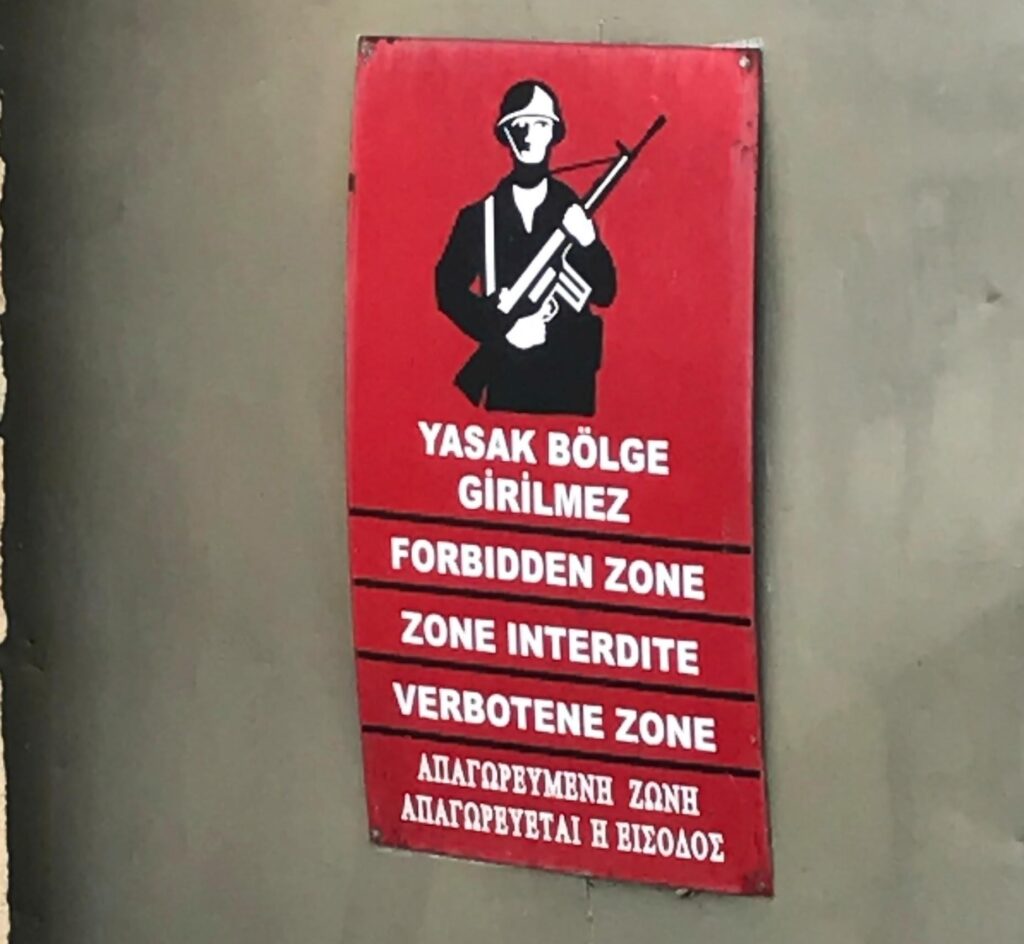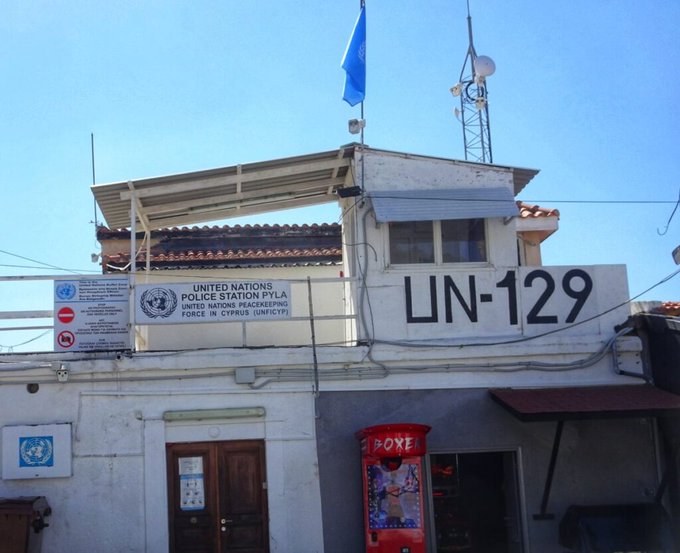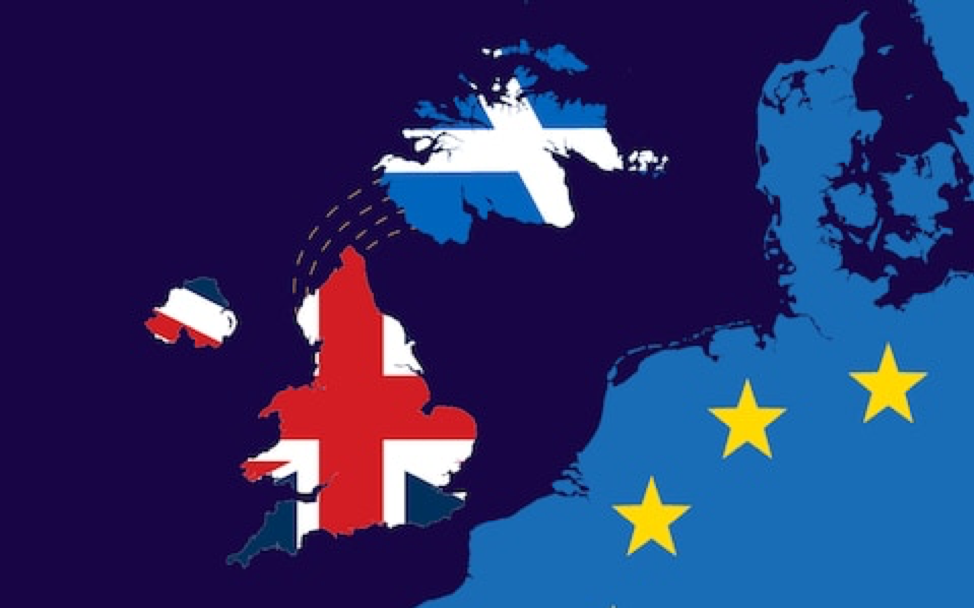Scenarios of Power in De Facto States: Karabakh’s 2020 Presidential Inauguration
All states have their iconographies and rituals designed to project their legitimacy and power. They organize space as sacred patrimony and time as memory, anniversary and the eternal. Presidential inaugurations are occasions where we see this process in scenarios and ceremonies of power. The United States has an oath-taking in front of dignitaries and a majestic Capitol building. France and Russia have public ceremonies featuring the journey of the elected leader to regal buildings of power, these very setting and their elaborate interior décor signifying a treasured and transcendent patrimony of the nation and state.
It is hardly a surprise that de facto states – states that have established territorial control and internal legitimacy in a contested region, but lack recognition in external legitimacy as states among other states in the international community – look to the ceremonies of established states when inventing their own ceremonies of power. How they do so is an interesting window into their prevailing constructions of the time-space of their visions of their territorial nation-stateness.
The 2020 presidential elections in the Nagorno-Karabakh Republic were not without controversy. They took place even as coronavirus cases steadily rose in Armenia next door – the only space through which people and goods move in and out of the territory. Expectations of a shift in power from old guards to new, analogous to what took place in Armenia in 2018, were never realistic. The elections were won by a former prime minister, Arayik Harutyunyan, who is also known to be a wealthy individual maintaining substantial business interests.
The manner of Harutyunyan’s triumph left lingering legitimacy questions. His opponent, however, retained his position as foreign minister even after calling for a boycott of the second round of voting – a strong indicator that stability and continuity are valued among the elite in Stepanakert and, indeed, Yerevan. Harutyunyan’s inauguration was held on May 21, 2020. Its television broadcast, just under an hour long, provides a fascinating visual record of how de facto states organise scenarios of power.
Continuity with Antiquity
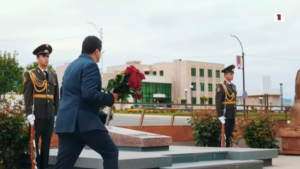
The opening scenario in this broadcast is the positioning of the present in the immediate past. It showcases the history of the Nagorno-Karabakh Republic and the person of Arayik Harutyunyan, including footage from the ’80s and ’90s, previous presidents taking office, the war, and early steps in the de facto state’s establishment. Among many acts of homage, Harutyunyan is shown bowing before the tomb of Karabakh’s first leader, Arthur Mkrtchyan, thus placing himself within a pantheon of past rulers.
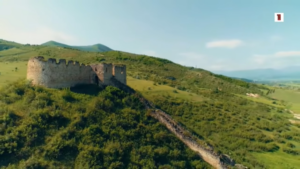
The second scenario is the projection of an ancient origin story. Sweeping aerial shots of ancient ruins, crumbling castle walls, enduring fortifications and historic churches transition the visual narrative to the mythic story of Artsakh, the local name for the Nagorno-Karabakh Republic. The male and female narrators speak of it as an impregnable fortress, the tenth province of Greater Armenia, a kingdom that existed between the 2nd century BC and the 5th century AD. The audience is informed that the local rulers of Artsakh maintained autonomy even in the face of foreign attacks, reaching its culmination during the era of the Five Melikdoms, a period of broad regional self-rule under Persian overlordship.
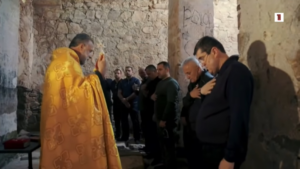
The third scenario positions Harutyunyan within the visual elements of this ancient story. He and a group of people pray with a priest in an ancient church whose dramatic setting on a cliff is displayed through aerial footage. Harutyunyan enters a mausoleum, kissing its inscribed threshold. The announcer notes that it is the final resting place of a semi-legendary king, Vachagan Barepasht (“the Pious”). Harutyunyan pays his respects, vowing to remain true to his roots. An important locational element is that this monastic complex is near the present Line of Contact with Azerbaijani forces. It is not an easily accessible nor a particularly well-known site, certainly not a touristic one.

The fourth scenario is a dark one, a recent history of suffering and genocide. The announcers recount massacres, genocide, and domination by Azerbaijan in the 20th century as historical black-and-white photographs of Shoushi run on the screen. The images of the city gutted and in ruins are a familiar and stark visual reminder to the audience of the recent past.

The opening preparatory video montage is filled with common imagery of churches and monasteries, books and manuscripts, striking mountainous landscapes, and nationalist discourse invoking a legitimating antiquity. In addition, references to the war within living memory and monuments to it, such as the tank that drove into Shoushi in 1992 and the memorial for veterans, bring both the history home and place Arayik Harutyunyan within it – laying flowers and bowing before each, he is presented as the bearer of a legacy and someone meant to continue a tradition. The announcers inform viewers that Harutyunyan himself fought for Shoushi at the age of nineteen. His final vow takes place at the city’s Ghazanchetots Cathedral – rebuilt in the 1990s, a symbol of resurgence – swearing before God and Armenian saints and martyrs.
Scenarios of Inauguration: Solemn Protocols

The opening scenario of inauguration is the arrival of the leader-elect. A rather humble silver-grey Hyundai drives up to the entrance of a newly-renovated hall in Shoushi and Harutyunyan steps out. He makes his way to the auditorium walking across a red carpet, saluted at various points by armed honour guards, not unlike Vladimir Putin’s 2018 inauguration ceremony. The auditorium is filled mostly with men, many without masks. Most significantly, the political elite of Armenia is in attendance, led by prime minister Nikol Pashinyan and the president of Armenia’s parliament Ararat Mirzoyan.
Also in keeping with Russian protocol – one sees this in the presidential investiture for Transnistria as well – the flag of the country is brought in with military honours. Unlike Russia and Transnistria, a 17th-century gospel also proceeds with the constitution. Both are ceremonially carried into the hall, accompanied by triumphant music.

Then we have the spectacle of oath taking. Harutyunyan places his right hand over the documents while reciting the oath of office, which notably includes vows to maintain the independence, sovereignty, and territorial integrity of the state, besides the constitution and human rights. Everyone stands as the national anthem of Karabakh is played, Harutyunyan visibly and sometimes audibly singing along.

Thereafter, we have the scenario of the address by the new leader. Harutyunyan speaks for 25 minutes or so – close to half the broadcast – recounting the same historical narrative as the prefatory exposition, with the same details, using the same vocabulary. He adds the well-known expression, “Artsakh is Armenia, period”.
The fate of both is fused in a resonant metaphor: “Because the republics of Artsakh and Armenia are inalienable parts of one united national homeland, therefore the sword dangling over the heads of the people of Artsakh must be taken to be a yataghan above the heads of all the Armenian people and its dignity.” The term “yatagan” or “yataghan” (“yatağan” in modern Turkish) refers to a particular type of short sword used in the Ottoman Empire. It is commonly employed in Armenian as a metaphor for existential Turkish threats. Harutyunyan unites the public historical memory of the Armenian Genocide with the current political struggle over the disputed territory, equating the Ottoman Turkish antagonist of the past with the Azerbaijani Turkish antagonist of the present – a common fusion characteristic of the conflict.
Harutyunyan also personalises the existential danger, telling the story of his brother who died during the Karabakh war. His conclusion repeats the defiant slogan, “Artsakh is Armenia, period”.

Harutyunyan’s inauguration ceremony is one long exercise in locating the current de facto state in the mythic space and time of the nation. The privileging of Artsakh as the entity’s name is central to this imagination, the ancient churches, ruins, tombs, and deaths mobilised to assert a continuity between an ancient signifier and the current polity. Throughout the proceedings, everyone – the announcers, other speakers, Harutyunyan – refer to the country exclusively as “Artsakh” or “the Republic of Artsakh”, never “Gharabagh”, “Lernayin Gharabagh” or “Lernayin Gharabaghi Hanrapetoutiun” (“Karabakh”, “Nagorno-Karabakh”, or “the Nagorno-Karabakh Republic”). The name evokes a time before there was any population in the region speaking any Turkic language, and before the advent of Islam. Indeed, there is much invocation of Christianity in the broadcast and ceremony as well, including the use of an old gospel, the address by the local bishop, and his blessing of Harutyunyan using a cross containing a holy relic.
Karabakh’s scenario of power transition aspires to accomplish three things. The first is to present Karabakh as a legitimate-looking state, and not a controversial entity holding a parochial ceremony in a small local hall. The investiture is an attribute of statehood, just like having a flag, constitution, and national anthem. The second is to provide Karabakh with an ancient past, a mythic identity as an enduring fortress on the frontline against enemies. The third is to legitimate Arayik Harutyunyan as a true son of Karabakh and worthy successor to past leaders.
Azerbaijan viewed the whole event as provocation, a “so-called “inauguration” in occupied territories.” Less than two months later, sadly, blood was once again being spilled over this intractable territorial conflict.
(All screenshots taken from the investiture broadcast available online.)
Authors: Gerard Toal & Nareg Seferian



